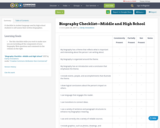
A checklist in student language used by high school students to self-assess their written biographies.
- Subject:
- English Language Arts
- Material Type:
- Assessment
- Date Added:
- 06/28/2017

A checklist in student language used by high school students to self-assess their written biographies.
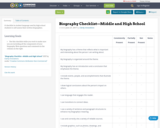
A checklist in student language used by high school students to self-assess their written biographies.
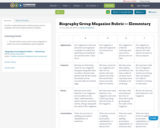
A rubric to help elementary student groups create a magazine that meets high standards of quality.
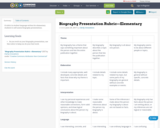
A rubric in student language written for elementary students to self-assess biography presentations.
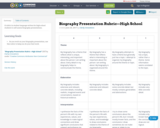
A rubric in student language written for high school students to self-assess biography presentations.
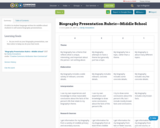
A rubric in student language written for middle school students to self-assess biography presentations.
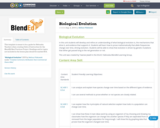
This template is meant to be a guide for Nebraska Teachers when creating Units of Instruction for the BlendEd Best Practices Project. Headings and/or topics not included in the lesson plan should be marked N/A.
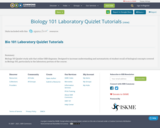
Biology 101 Quizlet study aids that utilize OER diagrams. Designed to increase understanding and automaticity of student recall of biological concepts covered in Biology 101, particularly in the laboratory portion of the course.
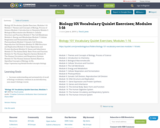
Biology 101 Vocabulary Quizlet Exercises, Modules 1-16
Module 1: Themes and Concepts of Biology, Process of Science
Module 2: Introduction to Chemistry
Module 3: Biological Macromolecules
Module 4: Cellular Structure and Function
Module 5: The Cell Membrane
Module 6: Energy and Metabolism
Module 7: Cellular Respiration and Fermentation
Module 8: Photosynthesis
Module 9: Somatic Cell Division, Reproductive Cell Division
Module 10: DNA Structure and Replication
Module 11: Gene Expression and Protein Synthesis
Module 12: Genes and Inheritance
Module 13: The Animal Body: Basic Form and Function
Module 14: The Human Digestive System
Module 15: The Human Circulatory and Respiratory Systems
Module 16: The Human Immune System
Based on OpenStax Concepts of Biology, 1st Ed.,
https://openstax.org/details/books/concepts-biology
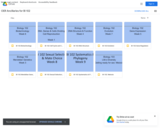
Slides for a 10 week course.
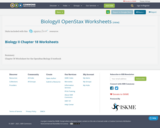
Chapter 18 Worksheet for the OpenStax Biology II textbook
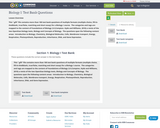
This “.gift” file contains more than 100 test bank questions of multiple formats (multiple choice, fill-in-the0blank, true/false, matching and short essay) for a Biology I course. The categories and tags are mapped to the content of Foundations of Biology 2.0 (Compton, Hyde and Williams, 2018) a remix of the two OpenStax biology texts, Biology and Concepts of Biology. The questions span the following content areas: Introduction to Biology, Chemistry, Biological Molecules, Cells, Membrane transport, Energy, Respiration, Photosynthesis, Reproduction, Inheritance, DNA, and Gene Expression.
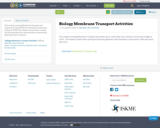
This module covering Membrane Transport was written by Dr. Karla Fuller from Guttman Community College of CUNY. The module contains files covering the learning objectives, demonstrations, assessments, think-pair-share, and more.

A biomaterial is essentially a material that is used and adapted for a medical application. Biomaterials can have a benign function, such as being used for a heart valve, or may be bioactive; used for a more interactive purpose such as hydroxy‐apatite coated hip implants (the Furlong Hip, by Joint Replacement Instrumentation Ltd, Sheffield is one such example – such implants are lasting upwards of twenty years). Biomaterials are also used every day in dental applications, surgery, and drug delivery .

This course presents a design philosophy and a design approach, dedicated to rehabilitation technology. This field was selected because of human-machine interaction is inherent and vital. Illustrative examples will be discussed by their entire design process

This is an Open Educational Resource created by University College Groningen (The Netherlands) students taking the course Biopsychology in Spring 2021.
In small teams, students were tasked with creating, composing, and curating an online portfolio dedicated to an interdisciplinary exploration of a topic of their choice. Their portfolio needed to be grounded in neuroscience, incorporate peer-reviewed research, and propose active learning exercises for future students and viewers.
Included topics:
- A trip through the world of psychedelics
- Alzheimer's disease
- Animal minds
- Biopsychological aspects of sexuality
- Consciousness
- Go with the flow: an interdisciplinary exploration of the flow state
- Happiness and well-being
- Hypnosis
- Intergenerational trauma
- Lucid dreaming
- Machine learning for mind reading
- Social and cultural neuroscience of prejudice
- Our sense of self
- Out of body experiences
- You and aesthetics
Please enjoy exploring their work!

Article critique assignment instructions for biopsychology course.

Sample Socratic questions and answers regarding the biosphere.
(Note: this resource was added to OER Commons as part of a batch upload of over 2,200 records. If you notice an issue with the quality of the metadata, please let us know by using the 'report' button and we will flag it for consideration.)
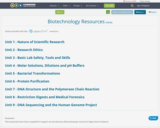
This materials have been compiled to support an introductory Biotechnology course for high school students.
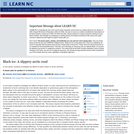
In this lesson students investigate the effects of black carbon on arctic warming and are introduced to a mechanism of arctic warming that is not directly dependent on greenhouse gases in the atmosphere: black carbon deposition on Arctic snow and ice. It can also be used to introduce the concept of albedo. Prerequisite knowledge: students understand the concepts of absorption and reflection of light energy. This lesson is designed to be used with either an Earth/environmental science or chemistry curriculum. It may also be used as an enrichment activity in physics or physical science during a unit on energy. Includes suggested modifications for students with special needs and low technology option. Requires advance preparation, including freezing ice samples overnight.